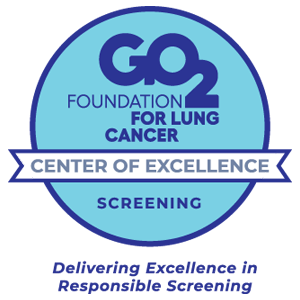Our Lung Cancer Screening Program is designed to detect lung cancer early — when it is most curable — by screening and monitoring the people most likely to develop the disease, especially smokers. The program involves:
- Taking a focused medical history
- A physical examination
- A Low-dose CT scan (LDCT) of the chest
Our screening focuses on people at high risk for developing lung cancer and as a result, 70% of the cancers we find with screening are early stage (stage 0, 1 and 2) compared to national statistics that show 70% of lung cancers are diagnosed at advanced stages (stage 3 or 4).
Low-Dose CT (LDCT)
This noninvasive scan, which does not require any contrast dye, finds suspicious nodules or lesions in the lung better than an X-ray. With LDCT, the scanner rotates around the patient, taking multiple images, which a computer reconstructs into a three-dimensional picture of the lungs. LDCT takes only seconds to obtain a detailed picture of the lungs and the radiation dose is less than the yearly exposure to background radiation in the environment.
Should I be screened for lung cancer?
Please contact us about lung cancer screening if you have:
- a history of cancer of the lung, esophagus, head, or neck (excluding cancer of the thyroid), or
- the following three factors:
- at least 50 years old
- have at least 20 pack/years of smoking
- was an active smoker within the last 15 years — even if you’ve quit
Other risk factors will be considered when deciding if additional testing, such as bronchoscopy, is needed. These may include:
- Asbestos-related lung disease such as pulmonary asbestosis
- History of chronic obstructive pulmonary disease (COPD) also known as emphysema
- Family history of lung cancer (parent, sibling or child)
- Profession with significant exposure noxious fumes, chemicals or smoke
Ask about our clinical trial that is studying whether a vaccine can prevent lung cancer in people at high risk.
Or, complete the Online Risk Assessment Form and one of our cancer information specialists with contact you.
How to start
- Call 1-800-ROSWELL (1-800-767-9355)
- Meet with a lung cancer screening expert at one of our locations below (or virtually if needed).
- Schedule your CT scan.
Our locations
Buffalo
Elm and Carlon Streets
Buffalo, NY 14263
Niagara Center
6324 William St., Ste 300
Niagara Falls, NY 14304
Jamestown
21 Porter Avenue
Jamestown, NY 14701
Southtowns
3041 Orchard Park Road
Orchard Park, NY 14217
Looking for a lung cancer screening location elsewhere in New York State? Find one at nylungcancerscreening.com.
What’s next?
If your CT scan is normal, you will be scheduled to repeat the scan in one to three years depending on your risk factors. We can help enroll you in smoking cessation programs and other cancer prevention initiatives.
If lesions or nodules are found, you may undergo further tests and biopsy to determine whether it’s actually cancer, or have repeat CT scans at recommended intervals. These decisions are based on the size, character and number of nodules found.
If you need a biopsy, Roswell Park uses the latest minimally invasive approaches including endobronchial ultrasound and robotic bronchoscopy, to safely perform the biopsy and get the answers you need to determine your next steps. In addition, you may be eligible to participate in clinical trials that focus on preventing lung cancer in people with early lung lesions.
Whether your screening shows small abnormal lesions or advanced disease, the lung cancer specialists at Roswell Park are here for you. We will arrange for any follow-up testing, biopsy or evaluation by our lung cancer care team.
The Roswell Park Advantage — Robotic Bronchoscopy for Early Diagnosis of Lung Cancer
An advanced technology — Robotic Bronchoscopy — is a game-changer for getting accurate biopsies of very small nodules deep in the lungs without surgery. As lung cancer screening increases, the lung nodules detected are smaller and harder to reach, making early-stage diagnosis and treatment difficult. With robotic bronchoscopy, we can safely biopsy nodules unable to be diagnosed with other approaches.


